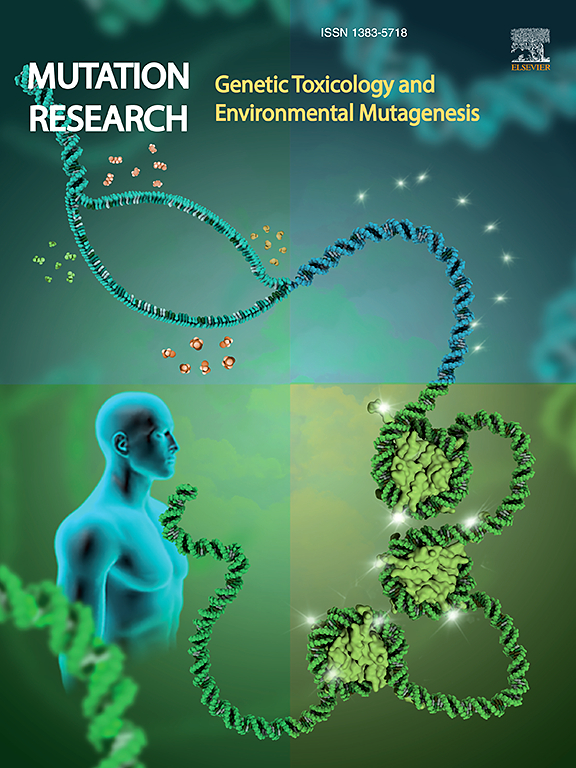Bleomycin induces short-term telomere fragility in Epstein-Barr virus-transformed human lymphoblastoid cells
IF 2.5
4区 医学
Q3 BIOTECHNOLOGY & APPLIED MICROBIOLOGY
Mutation research. Genetic toxicology and environmental mutagenesis
Pub Date : 2025-07-01
DOI:10.1016/j.mrgentox.2025.503877
引用次数: 0
Abstract
The induction of telomere dysfunction-related chromosomal aberrations by the radiomimetic antibiotic bleomycin (BLM) was studied in human lymphoblastoid cells immortalized with the Epstein-Barr virus (EBV). To this end, an EBV-induced lymphoblastoid cell line (T-37) was exposed to increased concentrations of BLM (10–100 µg/mL) for 2 h at 37ºC, and telomere aberrations were analyzed 24 h (first mitosis) after treatment using PNA-FISH with pan-telomeric plus pan-centromeric probes. Telomere signal duplications (TSD) increased significantly in BLM-exposed cells (p < 0.01), although the concentration-response relationship was non-linear. Most of the induced TSD (95–99 %) were of chromatid-type. No induction of telomere signal loss, telomere fusions or telomere associations by BLM was observed in T-37 cells. These findings show that BLM induces short-term telomere dysfunction in EBV-transformed human lymphoblastoid cells in the form of TSD (which implies telomere fragility) and suggest that these effects mainly occur during the G2 stage of the cell cycle. The persistence of this type of aberrations in the long-term in EBV-induced lymphoblastoid cells and other human cells exposed to BLM may be of medical relevance. Telomere fragility induced by BLM could promote genomic instability, which might contribute to the development of secondary tumors in patients undergoing chemotherapy based on this compound. Consequently, our study raises concerns about the potential long-term genomic effects of BLM in treated patients and suggests that the analysis of TSD could be a useful biomarker for detecting BLM-induced telomere dysfunction in human cells.
博莱霉素诱导Epstein-Barr病毒转化的人淋巴母细胞的短期端粒脆性
在用eb病毒(EBV)永生化的人淋巴母细胞样细胞中,研究了拟放射抗生素博来霉素(BLM)诱导端粒功能障碍相关染色体畸变的作用。为此,将ebv诱导的淋巴母细胞样细胞系(T-37)在37℃下暴露于浓度增加的BLM(10-100µg/mL)中2 h,并在处理后24 h(第一次有丝分裂)使用带有泛端粒和泛着丝粒探针的PNA-FISH分析端粒畸变。在blm暴露的细胞中,端粒信号重复(TSD)显著增加(p <; 0.01),尽管浓度-响应关系是非线性的。大多数诱导的TSD(95% ~ 99%)为染色单体型。在T-37细胞中未观察到BLM诱导端粒信号丢失、端粒融合或端粒关联。这些发现表明,BLM在ebv转化的人淋巴母细胞样细胞中以TSD的形式诱导短期端粒功能障碍(这意味着端粒脆弱),并表明这些影响主要发生在细胞周期的G2阶段。在eb病毒诱导的淋巴母细胞样细胞和其他暴露于BLM的人类细胞中,这种类型的畸变长期持续存在可能具有医学意义。BLM诱导的端粒脆性可促进基因组不稳定性,这可能导致基于该化合物的化疗患者继发性肿瘤的发展。因此,我们的研究引起了对BLM对治疗患者潜在的长期基因组影响的关注,并表明对TSD的分析可能是检测BLM诱导的人类细胞端粒功能障碍的有用生物标志物。
本文章由计算机程序翻译,如有差异,请以英文原文为准。
求助全文
约1分钟内获得全文
求助全文
来源期刊
CiteScore
3.80
自引率
5.30%
发文量
84
审稿时长
105 days
期刊介绍:
Mutation Research - Genetic Toxicology and Environmental Mutagenesis (MRGTEM) publishes papers advancing knowledge in the field of genetic toxicology. Papers are welcomed in the following areas:
New developments in genotoxicity testing of chemical agents (e.g. improvements in methodology of assay systems and interpretation of results).
Alternatives to and refinement of the use of animals in genotoxicity testing.
Nano-genotoxicology, the study of genotoxicity hazards and risks related to novel man-made nanomaterials.
Studies of epigenetic changes in relation to genotoxic effects.
The use of structure-activity relationships in predicting genotoxic effects.
The isolation and chemical characterization of novel environmental mutagens.
The measurement of genotoxic effects in human populations, when accompanied by quantitative measurements of environmental or occupational exposures.
The application of novel technologies for assessing the hazard and risks associated with genotoxic substances (e.g. OMICS or other high-throughput approaches to genotoxicity testing).
MRGTEM is now accepting submissions for a new section of the journal: Current Topics in Genotoxicity Testing, that will be dedicated to the discussion of current issues relating to design, interpretation and strategic use of genotoxicity tests. This section is envisaged to include discussions relating to the development of new international testing guidelines, but also to wider topics in the field. The evaluation of contrasting or opposing viewpoints is welcomed as long as the presentation is in accordance with the journal''s aims, scope, and policies.

 求助内容:
求助内容: 应助结果提醒方式:
应助结果提醒方式:


